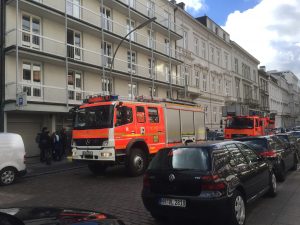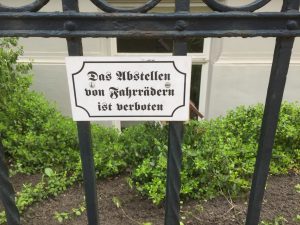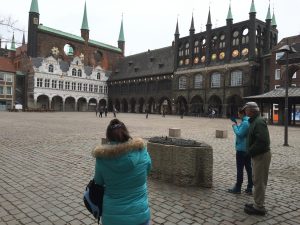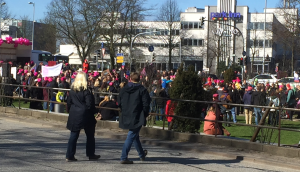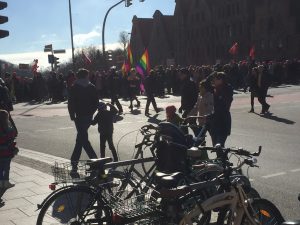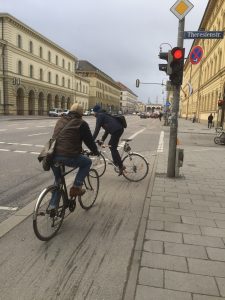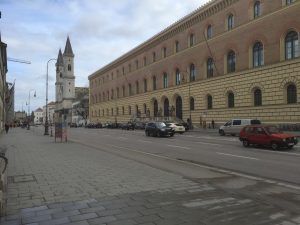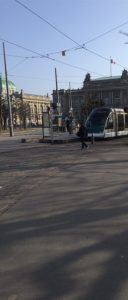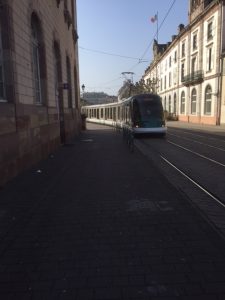There’s one more trip I must take. In Copenhagen, Denmark is a small museum called the David Collection. It owns another of the block prints I’m pursuing and I’m off to see it. I bought my train tickets a couple of days ago so all I had to do this morning was roll out of bed and make my way to the central station in Hamburg. I was excited to make this trip because the it involves the train being loaded onto a ferry for the trip from the north coast of Germany across a bay of the Baltic, the sea that separates the Danish island of Sjaelland from continental Europe. The first part of the trip went along the same route I had taken with Jim to Lübeck but continued on northeast to a little seaside town called Puttgarden. The town itself lies on the northern edge of a German island called Fehmarn. The names are more than slightly Danish and it’s no wonder. The Danes and Germans fought more than one war over this real estate up here. For the present, it’s German.
Public works projects generate intense debate everywhere. It’s no different in Germany and Denmark. Up here, there is a proposal to replace the ferry service with a bridge or tunnel or bridge/tunnel combination between the two countries at this point. But there’s opposition:
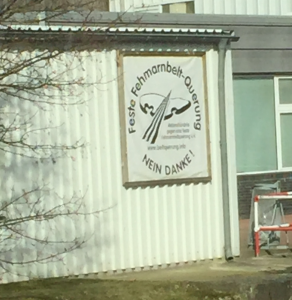
You can tell you’re getting close to the ocean because the land flattens and marshes, ponds, and inlets start appearing. Before you know it, the train is creeping onto a boat—a BIG boat– and then it comes to a stop. The train is only four cars long because it has to fit on the ferry, but even so, that’s a lot of train to carry on a boat. Then, it’s “everybody out” for the 45 minute crossing; train passengers as well as car and truck drivers are required to leave the vehicle decks while we’re underway. I spent the trip on the ferry “Princesse Benedikte” wandering around on the observation deck in surprising sunshine and browsing the duty free shops and restaurants in the enclosed areas.
Soon the crew of the ferry announces that we were approaching our destination, the Danish port town of Rødby, and we return to our seats on the train. The train is among the first vehicles to disembark; we set off on terra firma but halt at the first train station, about a quarter mile from the dock. Here the train is boarded by Danish police who politely ask all passengers for their passports. Despite Europe’s generous policy of accepting refugees, Denmark has decided it has had enough so they restrict entry to those who are carrying valid passports or other travel documents. I don’t see them remove anyone from our train…
We arrived in Copenhagen (I should probably write København since we’re now in Denmark—oops: Danmark!) about mid-afternoon. I checked into a modest hotel right next to the central train station. It’s called Nebo and I’ve stayed here before when Vibs and I have had occasion to visit the city. It’s a so-called “mission” hotel because it reflects a “Christian” philosophy that everyone deserves decent lodging. At about a hundred bucks a night, in the city center; it can’t be beat. Some of the rooms have shared baths and toilets but hey, they’re clean and neat.
I spent a bit of time in my room on the computer calculating a route from the hotel to the museum. Once I had done this, I headed out to reconnoiter my path. With a city plan firmly (more or less) in mental grasp, I walked the route I planned to take the next day. Contrary to expectations, the sun was out and the streets were busy. I walked the kilometer or so to H.C. Anderson Boulevard, which runs adjacent to Copenhagen’s grand Parliament building, the Rådhus.
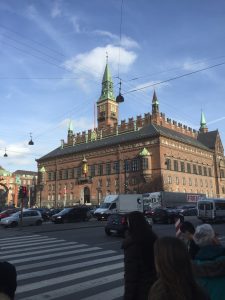
Crossing its plaza, which is a bit torn up due to the construction of a major subway project (the work has had Copenhagen in a traffic and aesthetic uproar for several years, now, but progress is being made…) and the erection of tents. The Danes were getting ready to celebrate St. Patrick’s Day. The Danes, supposedly the happiest people on the planet, are always up for a good time, even if it’s imported. On the other side of the plaza, I head up Strøget. Strøget is a main commercial street running for a mile or so through central Copenhagen. It’s a pedestrian street and the location of a number of iconic stores and businesses, some of them Danish—like Ilum’s and Georg Jensen—but increasingly American and European shops like Abercrombie & Fitch, Body Shop, Seven Eleven and, of course, MacDonald’s. Street performers were out in force: living statues of Elvis (in the later years), a black guy in dreads performing Bob Marley standards, another artist with a bucket of soapy water and a loop of rope lofting huge bubbles into the breeze. A typical city in other words.
Having determined that my route was accurate and walkable in a reasonable amount of time, I wandered slowly back toward my hotel, scouting out potential dinner locations along the way. The variety of cuisine options has greatly expanded here as it has elsewhere and the thought struck me as, later that evening, I sat at an all-you-can-eat sushi buffet. It seems that food as a cultural marker is losing its distinctiveness. That evening, across the room from where I sat, was your “typical” Danish young girl of about eight or ten: blond hair, blue eyes, Nordic to the bone. She was picking out dishes that her grandparents would never have heard of and that her parents had probably come to only as adults. Yet sushi would be a part of her cultural reference for all of her life, as natural as any other on the Danish landscape.
At ten the next morning, I presented myself at the David Samling. The building is on Kronprinsessengade, which borders one side of the park that surrounds Rosenborg Castle, the official residence of Denmark’s royal family. I met Anne-Marie Keblow-Bernsted, a conservator at the museum, who led me through a labyrinth of passageways to her workshop, where she does the labor necessary to preserve the textiles, paper, ceramics and other materials that constitute much of the collection. She had prepared the block print for me to examine and I spent a couple of hours doing just that. I also had the opportunity to talk with Ms. Keblow-Bernsted about her own work and particularly her study of Islamic ceramics. She had written a book on the subject of pigments and deterioration of glazes and such, a study of major importance in the field.
After expressing my thanks to her and the museum, I wandered back to toward the hotel, stopping off to make a few small purchases of items that are still hard to find outside of Denmark. The skies had been cloudy all morning and now the weather was definitely deteriorating. Taking a stiffening wind as a hint, I found a café where I could have some lunch and watch people through a window. Rain pounded down for a while, chasing pedestrians off the streets. A few disappointed St. Paddy’s Day revelers hustled past, shoulders hunched, hands buried in pockets, their green hats and fake red beards looking a tad bedraggled. By the time I finished my meal, the rain had let up enough that I could make a run for the hotel, retrieve my bag and make the short walk to the train station without getting soaked.
The train journey back to Germany was uneventful. Riding through the dark, we could have been anywhere. The ferry ride was a bit choppy, the boat shuddering through waves and wind but we docked without incident and by midnight I was snug at home.

